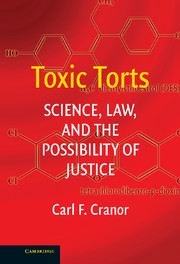Book contents
- Frontmatter
- Contents
- Preface
- 1 The Veil of Science over Tort Law Policy
- 2 Legal Background
- 3 Institutional Concerns about the Supreme Court's Trilogy
- 4 Studies of Toxicity and Scientific Reasoning
- 5 Excellent Evidence Makes Bad Law: Pragmatic Barriers to the Discovery of Harm and Fair Admissibility Decisions
- 6 Science and Law in Conflict
- 7 Enhancing the Possibility of Justice under Daubert
- 8 Is Daubert the Solution?
- Bibliography
- Index
4 - Studies of Toxicity and Scientific Reasoning
Published online by Cambridge University Press: 08 January 2010
- Frontmatter
- Contents
- Preface
- 1 The Veil of Science over Tort Law Policy
- 2 Legal Background
- 3 Institutional Concerns about the Supreme Court's Trilogy
- 4 Studies of Toxicity and Scientific Reasoning
- 5 Excellent Evidence Makes Bad Law: Pragmatic Barriers to the Discovery of Harm and Fair Admissibility Decisions
- 6 Science and Law in Conflict
- 7 Enhancing the Possibility of Justice under Daubert
- 8 Is Daubert the Solution?
- Bibliography
- Index
Summary
The law provides the institutional rules within which science will be utilized. Science often provides important content needed to assist in the resolution of legal disputes. However, scientific evidence is arcane, complex, and subtle. In order to better understand the law-science interaction, then, one should understand some of basic toxicity studies that are needed in the law as well as scientific reasoning from them to conclusions about human harm. This chapter reviews these subjects.
Early in this chapter, I provide some basic information about some of the main kinds of studies on which experts rely to make inferences about the potential of toxicants to cause adverse effects in persons. This summary seeks to acquaint readers, who might not be fully familiar with the science, with some of the types of studies and their features. I also review more extensively other kinds of evidence with which courts have had greater difficulties and that are less well understood. However, they are or potentially can be quite important in tort cases.
Later in this chapter I discuss less visible and less well-understood issues: scientific (nondeductive) inferences and some of their implications for scientific testimony. Surprisingly, a number of courts in their written opinions appear not to have understood different scientific studies, some of the reasonable inferences that can be made from them, and some of their limitations.
However, a deeper and broader understanding of the science and its context for the tort law is needed as well.
- Type
- Chapter
- Information
- Toxic TortsScience, Law and the Possibility of Justice, pp. 91 - 156Publisher: Cambridge University PressPrint publication year: 2006



